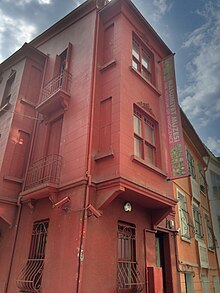Çukurcuma
This article is a rough translation from German. It may have been generated by a computer or by a translator without dual proficiency. |

Çukurcuma (pronounced chu-KUR-ju-ma;[1] English: "Friday Valley") is a neighborhood in the Beyoğlu district of Istanbul, Turkey. It is characterised by antique shops and cafés. The area is South-East of İstiklal Caddesi at a valley with a view on Bosphorus, not far from Galatasaray Square and between the quarters and Cihangir. connects the area. The buildings largely date from the 19th century, with some Ottoman buildings from the 15th century.
Geography[]
Administratively, it is in the districts ("Mahalleler") Kuloğlu and Firuzağa. It is located southeast of İstiklal Caddesi on a valley basin overlooking the Bosporus, southeast of Galatasaray Square and between the Tomtom and Cihangir districts. The Çukurcuma Caddesi runs through the area.
History[]
The area of today's quarter remained uninhabited throughout the Byzantine period. During the Conquest of Constantinople (1453), Sultan Mehmed the Conqueror is said to have initiated a Friday prayer in the valley. The Turkish words "çukur" for valley and "cuma" for Friday led to the term "Çukurcuma" which is still used today.[2] The is also said to go back to Mehmed. The current wooden structure was built between 1541 and 1547 under the architect Mimar Sinan on behalf of Shaikh al-Islam .
In the 19th century, starting from the İstiklal Caddesi , the building of housing mainly in the European Gründerzeit architectural style also expanded to Çukurcuma. In addition to ethnic Turks, not only Armenians and Greeks lived in the district, but also Western Europeans, who established schools, hospitals and diplomatic missions in Çukurcuma itself and in the neighboring districts. The Liceo Italiano “Galileo Galilei” has been in the district since 1882, as well as the Greek and the Greek Consulate General building on the edge of the neighboro. The 1955 Istanbul pogrom hit the neighborhood accordingly hard; almost all surviving Turkish Greeks and many Armenians subsequently emigrated.
Description[]

The district has retained a certain multicultural European character, and is known for its antique shops and cafés. It is sometimes referred to as the Bohème district.[2] The constituency is CHP-oriented, in contrast to the majority of the Beyoğlu district. In 2008, Orhan Pamuk published his book The Museum of Innocence, the action of which takes place in Çukurcuma. In 2012, Pamuk opened the museum of the same name in the district, which was designed by the German Sunder-Plassmann architects. The museum was recognized as European Museum of the Year in 2014.[3] The Guardian devoted an article to the district in 2008.[4] In 2012, the newspaper described Çukurcuma as one of the five best places to live worldwide.[5]
References[]
- ^ Schleifer, Yigal (2008-02-10). "Day Out: Cukurcuma, Istanbul – A More Intimate Grand Bazaar". The New York Times. Retrieved 2020-01-31.
- ^ a b "Istanbul's Bohemian Quarter: Çukurcuma". Skylife.com. Retrieved 2020-01-30.
- ^ "European Museum of the Year Award 2014". European Museum Forum. Archived from the original on 2014-06-09.
- ^ Lanyado, Benji (2008-09-12). "Streets ahead: Cukurcuma in Istanbul". The Guardian. Retrieved 2020-01-30.
- ^ Dyckhoff, Tom (2012-01-20). "The five best places to live in the world, and why". The Guardian. Retrieved 2020-01-30.
Coordinates: 41°1′53.87″N 28°58′49.98″E / 41.0316306°N 28.9805500°E
- Beyoğlu
- Istanbul pogrom
